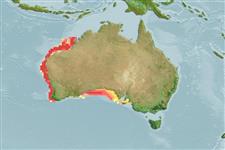Environment: milieu / climate zone / depth range / distribution range
экология
морской ассоциированный с рифами; немигрирующий; пределы глубины 1 - 200 m (Ref. 27560). Subtropical; 16°S - 36°S
Eastern Indian Ocean: endemic to Australian waters. Distributed from the Recherche Archipelago off Esperance, to Beagle Island, although they are rare north of Shark Bay. Records from Japan (Ref. 559, 12517) and Taiwan (Ref. 5193) are Glaucosoma buergeri (Ref. 27621).
Length at first maturity / Size / Вес / Возраст
Maturity: Lm 30.1, range 59 - ? cm
Max length : 122 cm TL самец/пол неопределен; (Ref. 27296); common length : 80.0 cm TL самец/пол неопределен; (Ref. 27621); наибольший вес (опубликованные данные): 26.0 kg (Ref. 27621)
колючие лучи спинного плавника (общее число) : 8; членистые (мягкие) лучи спинного плавника (общее число) : 11; колючие лучи анального плавника: 3; членистые (мягкие) лучи анального плавника: 9. One dark vertical band through eye which may disappear with an increase in size; 11 dorsal fin rays and 9 anal fin rays. Supraclavicle not developed into a bony shield. Peritoneum and gill rakers pale; lateral line with 44 to 48 pored scales; juveniles with wide dark horizontal bands wider than interspaces.
Westralian jewfish live in shallow inshore waters and depths to over 200 m (Ref. 27560). They are present over hard, flat sea beds (e.g. limestone shelf) and in reefs, wrecks and underwater caverns and gutters. Adult fish move into shallower waters in the cooler months between April and June (Ref. 27560, 27561). Juveniles tend to remain in shallower water than adults and are rarely found in waters more than 100 m deep (Ref. 27560). Adults feed mainly on fish, also rock lobsters, crabs, squid, octopus and cuttlefish. Marketed as fresh fish (Ref. 10384).
Female Westralian jewfish are broadcast spawners, releasing floating eggs into the water column; these are pelagic and can be carried large distances on ocean surface currents (Ref. 6390). Larvae feed on plankton (Ref. 6390).
McKay, R.J., 1997. FAO Species Catalogue. Vol. 17. Pearl perches of the world (family Glaucosomatidae). An annotated and illustrated catalogue of the pearl peches known to date. FAO Fish. Synop. 125(17):26p. Rome: FAO. (Ref. 27621)
Статус Красного Списка МСОП (Ref. 130435)
Угроза для людей
Harmless
Использование человеком
рыболовство: коммерческий; объект спортивного рыболовства: да
дополнительная информация
инструменты
Специальные отчеты
Скачать в формате XML
ресурсы в Интернет
Estimates based on models
Preferred temperature (Ref.
123201): 15.9 - 26.7, mean 20.4 °C (based on 86 cells).
Phylogenetic diversity index (Ref.
82804): PD
50 = 0.6250 [Uniqueness, from 0.5 = low to 2.0 = high].
Bayesian length-weight: a=0.01622 (0.00767 - 0.03431), b=2.94 (2.74 - 3.14), in cm total length, based on LWR estimates for this (Sub)family-body shape (Ref.
93245).
Trophic level (Ref.
69278): 4.3 ±0.62 se; based on food items.
устойчивость к внешним воздействиям (Ref.
120179): средний (среднего размера), минимальное время удвоения популяции 1.4-4.4 года (tm=3-4; Fec=300,000).
Fishing Vulnerability (Ref.
59153): High to very high vulnerability (72 of 100).
Nutrients (Ref.
124155): Calcium = 13.1 [7.2, 22.1] mg/100g; Iron = 0.462 [0.271, 0.742] mg/100g; Protein = 20 [19, 21] %; Omega3 = 0.209 [0.128, 0.335] g/100g; Selenium = 24.5 [12.8, 44.0] μg/100g; VitaminA = 50.5 [18.2, 135.2] μg/100g; Zinc = 0.478 [0.332, 0.687] mg/100g (wet weight);
